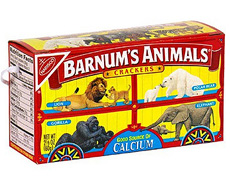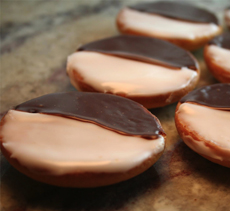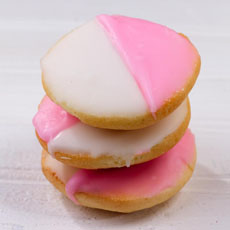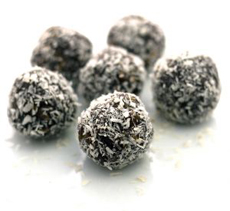Cookies Glossary: A Glossary Of The Different Cookies TypesPage 1: Terms Beginning With A To B This is Page 1 of an 10-page article. Click on the red links below to visit other pages. This glossary is protected by copyright and cannot be reproduced in whole or part. You are welcome to link to it. |
 Buckeye cookies are named for the horse chestnuts of the Buckeye tree, and are very popular in the Buckeye State, Ohio. Photo courtesy WMMB. |
|
| Cookie Types:
There are eight basic types of cookies: bar cookies, drop cookies, fried cookies, molded cookies, no-bake cookies, refrigerator (ice box) cookies, rolled cookies and sandwich cookies. You can see the overview of the different types of cookies, or read the individual listings in this glossary. ALMOND COOKIE: ALMOND BUCKEYE or BUCKEYE COOKIE: ALMOND LACE COOKIE: |
||
| AMARETTI: Amaretti are the original macaroons; the name means bitter almond. The cookies were developed in an Italian monastery during the Renaissance. The original macaroon, a small, domed shape that is crisp and crunchy on the outside and soft inside, evolved into the French-style macaroon as well as the coconut macaroon. See macaroon and read the history of macaroons. |
 Amaretti cookies. Bake your own with this amaretti cookie recipe. Amaretti cookies. Bake your own with this amaretti cookie recipe. |
|
| ANIMAL CRACKERS or ANIMAL COOKIES: The type of animal crackers that we know today date to 19th-century England. They were first imported; in the latter part of the century they were manufactured domestically. “Zoologicals” made by local baker Walter G. Wilson were sold at the 1876 Centennial Exposition in Philadelphia. Two New York companies, Herfield & Ducker (in Brooklyn) and Vandeveer & Holmes Biscuit Company in Manhattan, manufactured them year-round. Both companies were ultimately acquired by the New York Biscuit Company, which then became part of the National Biscuit Company (known today as Nabisco). In 1902, the product was repackaged as Barnum’s Animals Crackers (the “s” on animals was later dropped) and placed into the current circus cage box for the Christmas season. A string was attached so the box could be hung from the Christmas tree. Several other companies, including Keebler, make animal crackers today. They can be found in chocolate-covered versions as well.
|
 A childhood favorite, the box was originally designed to hang on the Christmas tree. Photo courtesy Nabisco. |
|
| BAR COOKIES: One of the eight basic types of cookies; batter or other ingredients are poured or pressed into a rectangular pan (sometimes in multiple layers), then baked and cut into individual-sized squares. Brownies and lemon bars are examples of bar cookies. In the U.K., bar cookies are known as “tray bakes". |
||
| BENNE WAFER or SESAME SEED COOKIE: A specialty of the South Carolina Low Country since Colonial times, benne is the Bantu word for sesame. The herb seed was brought from East Africa and planted extensively throughout the South. The benne wafer is a thin cookie, made with toasted sesame seeds. Plain benne wafers are often served with cocktails. They are also made into sandwich cookies, as shown in the photo.
|
 Benne wafers in a cookie sandwich. Photo courtesy Wisconsin Milk Marketing Board. |
|
| BISCOTTI: Italians call biscotti cantucci, and use the term biscotti to refer to any type of crunchy cookie, round, square and otherwise (as the British use the word biscuit). In North America, we use the term biscotti as the ancient Romans did, to describe a long, dry, hard twice-baked cookie—in other words, cantucci. While the Tuscan cantucci di Prato were only almond flavored, outside of the region the recipe expanded to include anisette-, amaretto- and lemon-flavored dough and to other spices; to biscotti with raisins and other dried fruits; to biscotti studded with chocolate morsels and with other varieties of nuts. Today, the flavorings are only limited to the imagination of the baker and the palates of the customer. Read the history of biscotti and learn more about cantucci. Other twice-baked cookies include the Dutch rusk, French biscotte and the German zwieback.
|
 The finger-shaped cookies we call biscotti are called cantucci in Italy. Photo by Claire Freierman | THE NIBBLE. The finger-shaped cookies we call biscotti are called cantucci in Italy. Photo by Claire Freierman | THE NIBBLE. |
|
| BISCUIT: The British word for cookie, biscuit, comes from the Latin bis coctum, meaning “twice baked” (also the origin of the Italian word biscotti). BLACK & WHITE COOKIE:
The exact origin of the Black-and-White cookie is uncertain, although they were a New York City specialty. The earliest printed reference we’ve found is a testimony from a third-generation baker at Glaser’s Bakery on the Upper East Side, who noted that the bakery had made them since they opened in 1902 (source). The bakery is still there! Given that the founder was a baker from Germany, you could think that the recipe came from there; but in Germany, they’re called Amerikaner (American) cookies. Here’s another clue.
|
 Above: Black and white cookie from New Yawk Baking Co. Center: Artsy black and white cookies from Dana’s Bakery. Bottom: Pink and white cookies for National Breast Cancer Awareness Month (October).  
|
|
| BOURBON BALL or CHOCOLATE BOURBON BALL: A no-bake cookie made of chopped toasted nuts, finely crushed wafer or shortbread cookies, cocoa powder and Bourbon, held together with light corn syrup. Sometimes the balls are rolled in confectioners’ sugar. Rum can be substituted for Bourbon.
|
 Chocolate Bourbon Balls. Photo by Teodora Vlaicu | SXC. |
|
| BREAKFAST COOKIE: Looking for any excuse to eat a cookie, someone created a granola cookie with whole wheat flour, substituted honey and molasses for the sugar, and dubbed it a ”breakfast cookie.” The recipes became more elaborate, for example, using cherry almond granola, orange pecan granola, and chocolate chip granola. You can fool some of the people some of the time, but a breakfast cookie is still a cookie—just as muffins are a different form of cake. BROWNIES & BARS:
|
 Brownies available from MackenzieLtd.com. |
|
|
BUCKEYE COOKIE: Inspired by the horse chestnuts that fall from Ohio’s famous buckeye trees, both cookies and candy called “Buckeye” are a specialty of The Buckeye State. The name “Buckeye” comes from Native Americans who felt that the nut of the Buckeye tree resembled the eye of a buck deer. The light, round center of the cookie and candy resembles the golden-brown husk of the of the nut. The cookies and candy are generally made with almonds rather than than chestnuts. Here’s a recipe for the cookie.
|
 Buckeye cookies. Photo courtesy WMMB. |
|
|
BUTTER BALL: A meltaway shaped into a ball. When chopped pecans are added, they are called pecan balls. BUTTER COOKIE: Fennel pistachio butter cookies from the Wisconsin Milk Marketing Board. Get the recipe
|
 |
|
Last Updated May 2018
© Copyright 2005-2025 Lifestyle Direct, Inc. All rights reserved. All images are copyrighted to their respective owners.